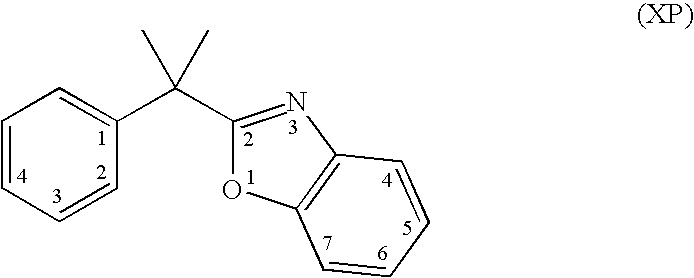Vitamin D receptor modulators
a technology of vitamin d receptor and transcription factor, which is applied in the field of ligand-dependent transcription factor, can solve the problems of insufficient separation to allow oral administration, hampered use of conventional vdr ligands, and inability to restore lost bone structure,
- Summary
- Abstract
- Description
- Claims
- Application Information
AI Technical Summary
Problems solved by technology
Method used
Image
Examples
example 1
Preparation of 2-{1-[4-(3,3-dimethyl-2-oxo-butoxy)-3-methyl-phenyl]-1-ethyl-propyl}-benzooxazole-6-carboxylic acid
[0110]
A. 1-Benzyloxy-4-iodo-2-methyl-benzene
[0111]
[0112]A mechanically stirred mixture of 4-iodo-2-methylphenol (1.62 moles; 391 g), cesium carbonate (1.99 moles; 650 g), and 1.75 L of acetone is treated with benzyl bromide (1.70 moles; 203 mL; 291 g) over 15 m. The reaction mixture was stirred for 21 h at RT and filtered. The filter cake is washed with 1 L of acetone, and the combined filtrates are concentrated. The crude semi-solid is recrystallized from pentane to give 475 grams (90%) of the desired product as a white solid. 1H NMR (CDCl3) δ: 7.40 (m, 7H), 6.64 (d, J=8.6 Hz, 1H), 5.06 (s, 2H), 2.24 (s, 3H).
B. 2-(4-Benzyloxy-3-methyl-phenyl)-2-ethyl-butyric acid methyl ester
[0113]
[0114]To a mixture of 1-benzyloxy-4-iodo-2-methyl-benzene (494 mmoles; 160 g) and lithium bis(trimethylsilyl)amide (1.20 moles; 200 g) in 250 ml of toluene at 0-5° C. is added a solution of 2-...
example 2
Preparation of 2-{1-[4-(3,3-Dimethyl-2-oxo-butoxy)-3-methyl-phenyl]-1-ethyl-propyl}-benzooxazole-6-carboxylic acid amide
[0128]
[0129]A solution of 2-{1-[4-(3,3-dimethyl-2-oxo-butoxy)-3-methyl-phenyl]-1-ethyl-propyl)}-benzooxazole-6-carboxylic acid (150 mg, 0.343 mmol) in CH2Cl2 (5.0 mL) is treated with DMAP (125 mg, 1.03 mmol) and EDC (99 mg, 0.514 mmol). The mixture is stirred for 15 m at RT before the addition of aqueous ammonium hydroxide (1.0 mL, 30%). The reaction is stirred for 18 h and quenched with aqueous NH4Cl (5.0 mL). The organic layer is loaded on silica gel column and purified with 50% EtOAc / Hex to afford the title compound (40 mg, 27%). MS (ES) m / e: 437.3 (M+1).
example 3
Preparation of 2-{1-[4-(3,3-Dimethyl-2-oxo-butoxy)-3-methyl-phenyl]-1-ethyl-propyl}-benzooxazole-6-carboxylic acid dimethylamide
[0130]
[0131]2-{1-[4-(3,3-Dimethyl-2-oxo-butoxy)-3-methyl-phenyl]-1-ethyl-propyl}-benzooxazole-6-carboxylic acid (150 mg, 0.343 mmol) in CH2Cl2 (5.0 mL) is treated with DMAP (125 mg, 1.03 mmol) and EDC (99 mg, 0.514 mmol). The mixture is stirred for 15 m at RT, and dimethylamine hydrochloride (42 mg, 0.514 mmol) is added. The reaction is stirred for 18 h and quenched with aqueous NH4Cl (5.0 mL). The organic layer is loaded onto a silica gel column and purified with 50% EtOAc / Hex to afford the title compound (125 mg, 79%). MS (ES) m / e: 465.3 (M+1).
PUM
| Property | Measurement | Unit |
|---|---|---|
| temperature | aaaaa | aaaaa |
| weight percent | aaaaa | aaaaa |
| weight percent | aaaaa | aaaaa |
Abstract
Description
Claims
Application Information
 Login to view more
Login to view more - R&D Engineer
- R&D Manager
- IP Professional
- Industry Leading Data Capabilities
- Powerful AI technology
- Patent DNA Extraction
Browse by: Latest US Patents, China's latest patents, Technical Efficacy Thesaurus, Application Domain, Technology Topic.
© 2024 PatSnap. All rights reserved.Legal|Privacy policy|Modern Slavery Act Transparency Statement|Sitemap



